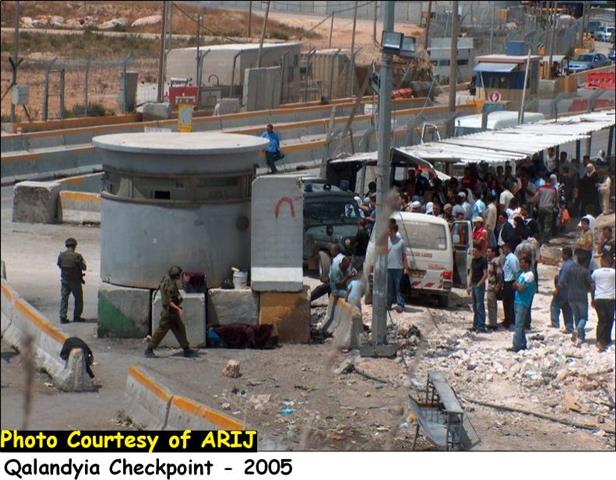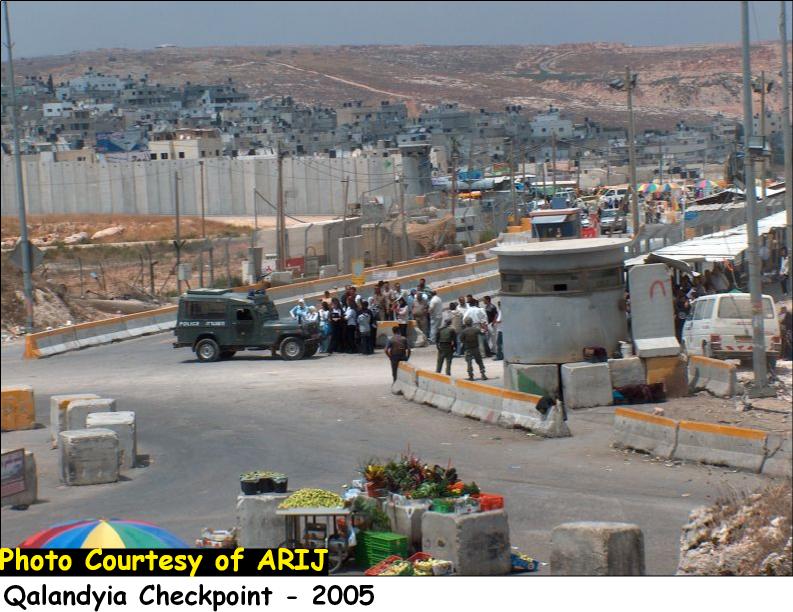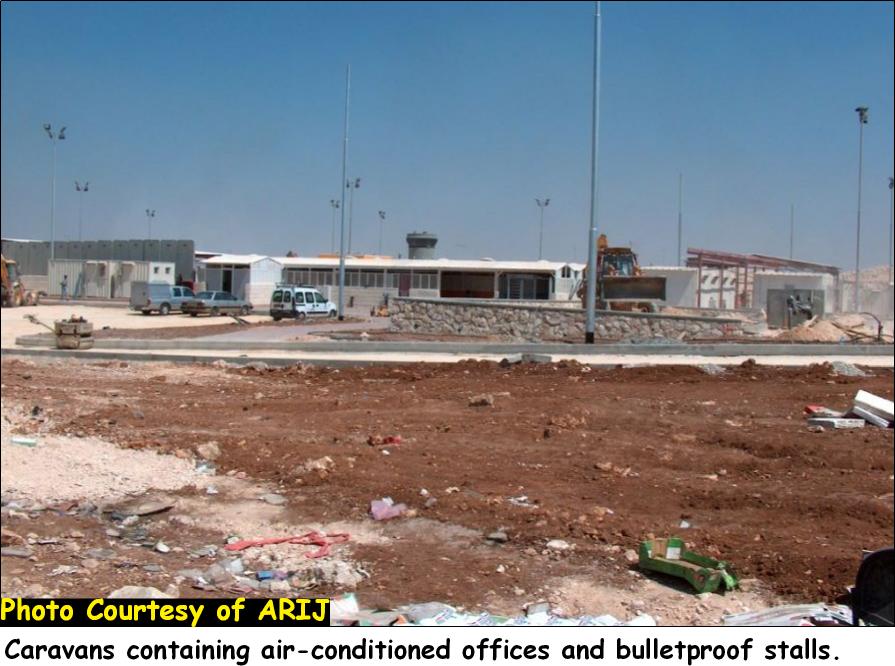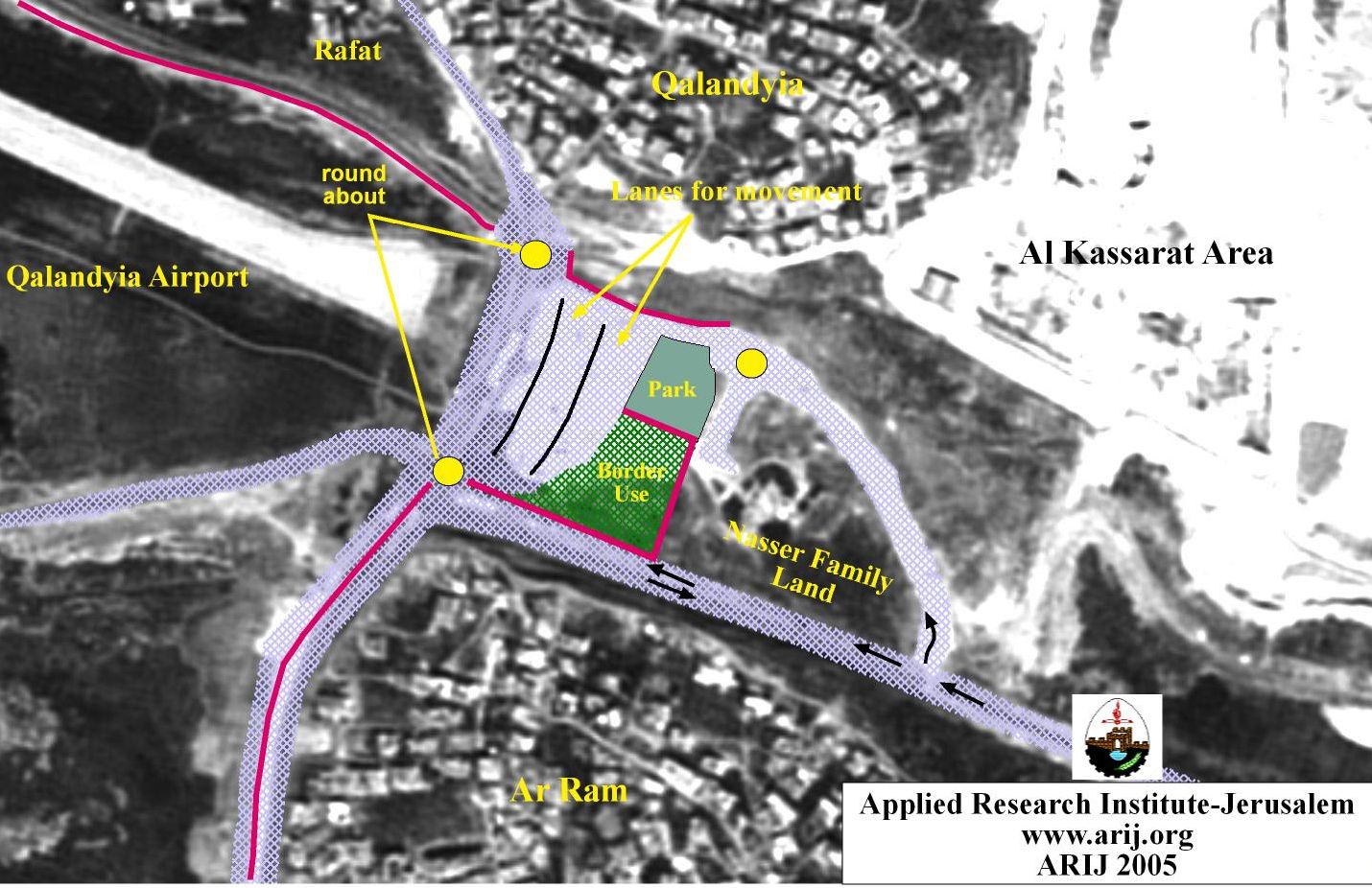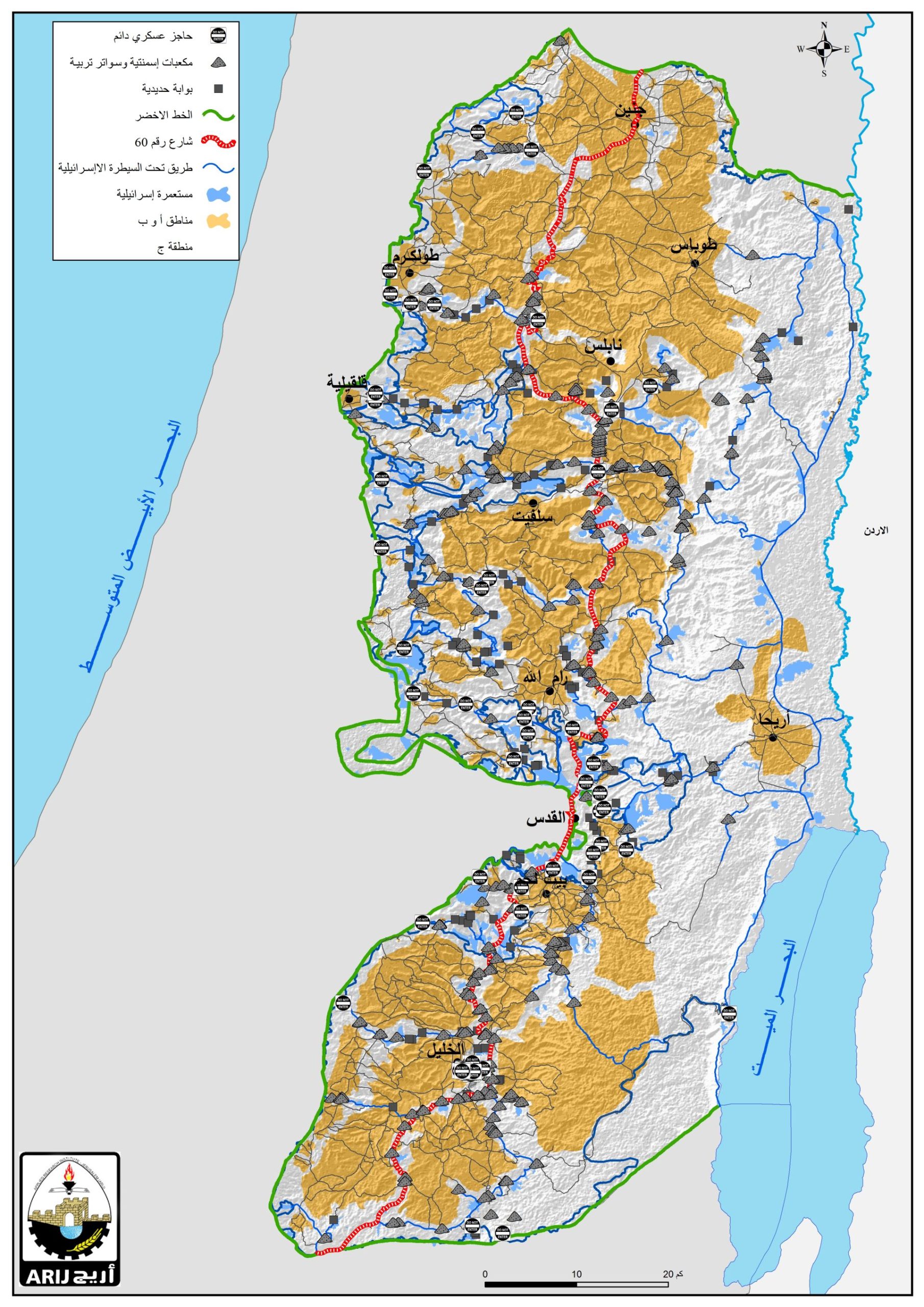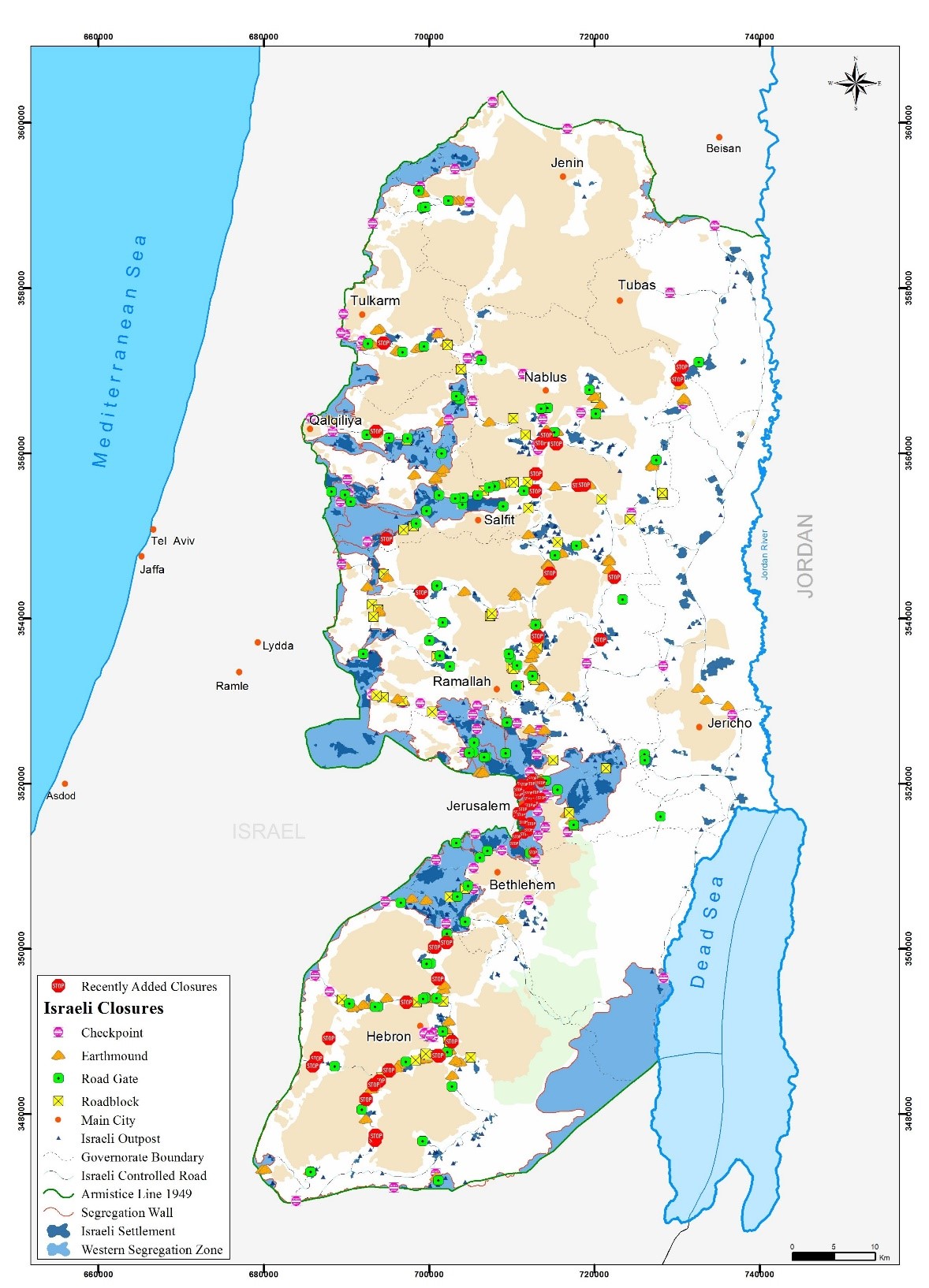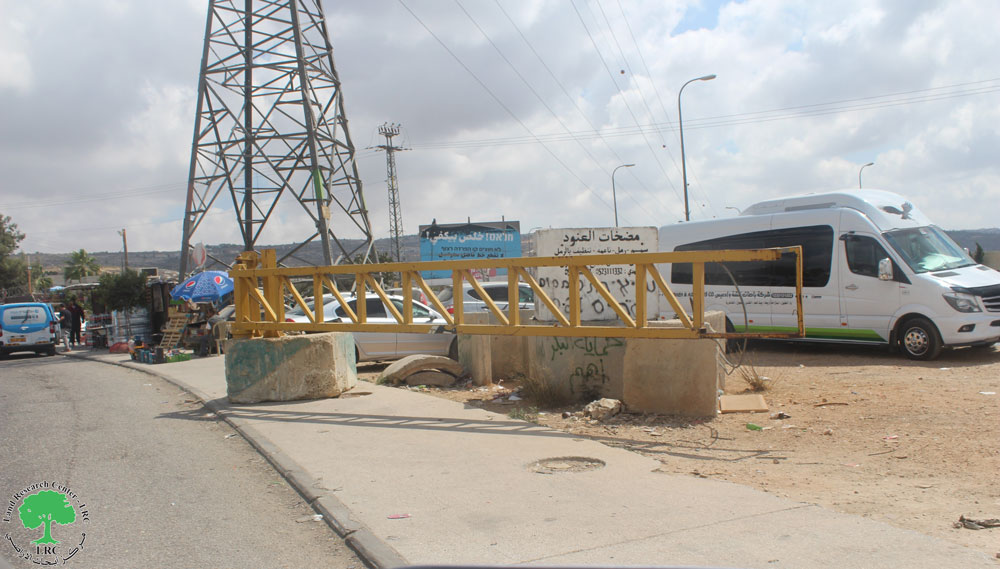Introduction:-
Qalandyia checkpoint was constructed in the year 2000, on a flat and dusty area on the main road between Jerusalem and Ramallah in the vicinity of Qalandyia airport. The checkpoint cuts the historic link between Jerusalem and Ramallah and between the northern cities of the West Bank and the southern cities. The checkpoint has developed and fortified through out the years. It now consists of low concrete barriers that obstruct car movements and is equipped with mechanical devices used to control pedestrian movements (usually consist of several horizontal arms supported by and projecting from a central vertical post and allowing only the passage of one person at a time), and military watch towers for monitoring the pedestrian and vehicular movements. See Photo 1 & Photo 2 & Photo 3 & &
Ever since the checkpoint was erected, it has been subjected to constant changes through the addition of magnetic ports, barbed wires and concrete blocks to disrupt the movement of Palestinians heading to their destinations. Finally after building the Segregation Wall at Qalandyia, the Israeli authorities revealed their plans of converting the checkpoint into a big terminal, which is currently in its final stages of construction. See Photo 4, Photo 5 & Photo 6, &
The link between the West Bankâ??s Northern and Southern Districts
Qalandyia checkpoint, ever since was erected in 2001, has proven to be a source of impediment to Palestinian movement, especially between the northern and southern West Bank Governorates, blocking the usual routes that were used by Palestinians before the eruption of the Second Intifada in 2000. Furthermore, the implementation of the Segregation Wall plan at Qalandyia area has made the situation even more difficult in that it cuts the links between the roads leading to Bethlehem and Hebron governorates in the south and the roads leading to Jerusalem and Ramallah governorates north.
Terminals along the path of the wall
Israel, announced in December 2004 its plan to set up five trade terminals or passages along the path of the Segregation Wall under the basis of back to back goods exchange throughout the West Bank to the areas west of the Segregation Wall and to Israel which will also control the Palestinian movement. The passages are: Al Jalameh in Jenin, Sha'ar Ephraim in Tulkarem, Betunia in Ramallah, Mazmuria in Bethlehem, and Tarqumia in Hebron. Israel even asked the World Bank to finance the construction of these five terminals but the World Bank rejected the plans because three of the terminals, Al Jalameh, Betunia and Mazmuria, are located inside the West Bank rather than on the Green Line (the 1949 Armistice line). Later in June 2005, Israel announced setting up two other terminals, one in Qalandyia and the other in Qalqiliya.
Construction works in the new Qalandyia terminal first started in March 2005, before the Israeli Government announced its plan to construct the previously mentioned two new terminals. A number of Israeli bulldozers started razing the lands east of Qalandyia checkpoint on the land confiscated by the military order number (T/100/04) preparing the infrastructure for the terminal. See Copy of the military order) preparing the infrastructure for the terminal.
Weeks later, caravans were added to the site which would contain air-conditioned offices, bulletproof stalls, high tower for telecommunication purposes, in addition to bathrooms, sewage and water networks to transfer the area into a civil administration office such as the one in Beit 'El settlement north of Al Bireh city where Palestinians can get permits at favor of passing through Israeli checkpoints. See Photo 3 & Photo 4
Large cement blocks and towers were also erected, commencing the construction of a section of the Segregation Wall around the area. Today, the equipped terminal is almost replacing the Qalandyia checkpoint with 6 lanes for pedestrians and 4 lanes for vehicular movement. See Map of Qalandyia Crossing Border.
To the east of Qalandyia checkpoint, a new road leading to Ramallah was erected. This Road is going to allow residents of the West Bank and Palestinians in Al Ram and Dahiyet Al Barid to enter Ramallah and go through Qalandyia checkpoint making sure that they have to undergo an inspection point within the terminal. The residents of Al Ram and Dahiyet Al Barid holding the Jerusalem IDs if willing to reach Jerusalem will have to go through the new erected road first and then through the terminal.
In September 2005, Israel announced about 10 main terminals to be constructed in the West Bank in addition to 23 crossing points along the path of the Segregation Wall (Haaretz newspaper, Sep.9, 2005). The ten terminals included the previously mentioned ones in addition to Hasam Tzahub in the upper Jordan valley, Terminal 300 in Bethlehem, Shu'fat Camp, Az 'Ayyem and Qalandyia terminals in Jerusalem. The ten terminals are to control the movement of more than 2 million Palestinians once they're fully constructed.
Difficulties inflicted by the construction of the Segregation Wall
The transformation of Qalandyia checkpoint into a terminal or border crossing will affect the status of movement from Jerusalem to the West Bank Governorates. Additionally, Palestinian Jerusalemites will have restricted movement into Ramallah and the rest of West Bank Governorates. See map 1. It is worth mentioning that the terminal will be the only link between north of the West Bank with the south and will be the new Israeli imposed border for Jerusalem.
Disengaging from Palestinians
The Israeli Prime Minister Ariel Sharon is swiftly reinforcing the construction of the Segregation Wall in the Palestinian Territory by setting up new terminals along its route, unilaterally and gradually disengaging from Palestinians and confiscating more of the Palestinian lands. It is worth mentioning that the Wall is a blatant violation of International law, specifically The Hague Regulations of 1907 and the Fourth Geneva Convention of 1949 which state:
-
The Hague Regulations expressly forbids an occupying power 'to destroy or seize the enemy's property, unless such destruction or seizure is imperatively demanded by the necessities of war' (Article 23).
-
Article 53 of the Fourth Geneva Convention is also clear that: 'any destruction by the Occupying Power of real or personal property belonging individually or collectively to private persons, or to the State, or to other public authorities, or to social or cooperative organizations, is prohibited, except where such destruction is rendered absolutely necessary by military operations.'
-
The appropriation and destruction of Palestinian land is also a breach of the Fourth Geneva Convention, Article 147 which clearly prohibits, ''extensive destruction and appropriation of property, not justified by military necessity and carried out unlawfully and wantonly.''
Related Cases
Prepared by:
The Applied Research Institute – Jerusalem


